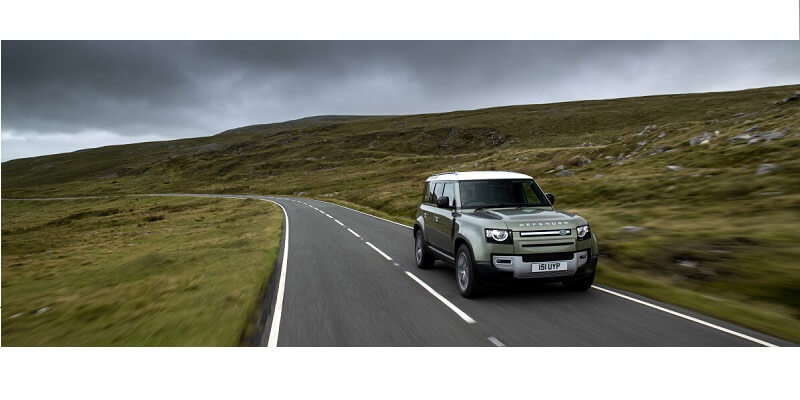The post traces the latest developments that took place this week in the fields of autonomous vehicles, connected vehicles, electric mobility and shared mobility.
Jaguar Land Rover to begin tests on a hydrogen fuel-cell prototype model
Jaguar Land Rover earlier this year had announced that it plans to be entirely electric by 2025, and launch six pure electric models over the next five years. Now the company plans beginning of tests later this year on a hydrogen fuel-cell prototype model based on its Land Rover Defender vehicle. The vehicle will undergo tests to verify key attributes such as off-road capability and fuel consumption.
Hydrogen-powered vehicles, which generate electricity from hydrogen to power an electric motor, are complimentary to battery electric vehicles. They also provide high energy density and rapid refuelling, and minimal loss of range in low temperatures, the carmaker therefore considers this technology ideal for larger, longer-range vehicles, or those operated in hot or cold environments.
Waymo working with J.B. Hunt as it looks to commercialize its Waymo Driver for trucking
Waymo is looking to commercialize its Waymo Driver for trucking, and is now working with J.B. Hunt, one of the largest transportation logistics companies in the U.S., to autonomously transport loads in Texas for one of their leading customers. The companies will use Class 8 trucks operated by the Waymo Driver on hauling goods between facilities in Houston and Fort Worth. The learnings from these trials will be used by the companies to advance the trucking industry through the deployment of autonomous driving technology, said Waymo in its blog.
NVIDIA to acquire DeepMap
NVIDIA has agreed to acquire DeepMap, a startup dedicated to building high-definition maps for autonomous vehicles. DeepMap was founded five years ago by Wu and Mark Wheeler, veterans of Google, Apple and Baidu, among other companies. The U.S.-based company has developed a high-definition mapping solution that has been validated by the AV industry. DeepMap’s technology will be used to bolster the mapping and localization capabilities available on NVIDIA DRIVE, a software-defined, end-to-end platform. The acquisition is expected to close in the third calendar quarter of 2021.
Environmental impact of battery electric vehicles is significantly lower than ICE vehicle: Scania
Scania recently published a life cycle assessment (LCA) of distribution vehicles. The LCA concluded that the environmental impact of battery electric vehicles is significantly lower than that of a vehicle with an internal combustion engine. Life Cycle Assessment is an ISO 14040/44 method to calculate the environmental impacts of products, covering the entire life cycle from cradle to grave, starting at the extracting and refining of raw materials and ending at the recovery of, in this case, the vehicles.
The production of the battery electric vehicle entails a higher environmental impact, mainly due to energy intensive battery cell manufacturing. Despite the increased production burden, the total life cycle impact on climate change is dramatically better for the battery electric vehicles, thanks to the much lower carbon impact from the use phase.
EB adds Vehicle-to-Grid Communications to its tresos product line
Elektrobit (EB), a supplier of embedded and connected software products for the automotive industry, recently announced a solution that promises to make it easier and faster to develop next-generation EVs with the advanced vehicle-to-grid (V2G) capabilities.
The company announced two major additions to its Classic AUTOSAR product line. EB has added EB tresos V2G ChargeIn, a new, in-vehicle, AUTOSAR-compatible software module that—in combination with an ISO 15118-compliant communication stack—enables ECUs to manage the communication between the charging system inside the vehicle and the charging station. In addition, through a partnership with SEVENSTAX, EB tresos AutoCore now integrates the fully ISO 15118-compliant SEVENSTAX application stack, supporting the latest V2G communication features.
ISO 15118 is an international standard that outlines the digital communication protocol that an electric vehicle (EV) and charging station should use to recharge the EV’s high-voltage battery.
Velodyne Lidar introduced the next generation of its Velabit sensor
Velodyne Lidar has introduced the next generation of its Velabit sensor. Equipped with its micro-lidar array architecture (MLA), the product aims at addressing issues like the cost, safety, and design challenges of autonomous solutions while delivering state-of-the-art performance, said the company in a Press Release. The Velabit will delivers an ultra-wide field of view (FoV) and higher resolution as it simultaneously has achievable maximum horizontal FoV of 90° and maximum vertical FOV of 70°, approximately three times more points per second than the previous model.
Pirelli and Enel X plan to install recharging infrastructure at tyre centers
The electric vehicles today face a hurdle in the insufficient number of recharging points. To address this issue Pirelli and Enel X plan to install recharging infrastructure, from the Enel Group’s business line for electric vehicles, at selected sales points of the Driver network of tyre centres. The installation will begin with many Pirelli tyres centres in Italy, to be followed by Spain and other European countries.
The cooperation between Pirelli and Enel X is part of a European wide plan for the development of Driver services for e-mobility. The recharging stations at the Pirelli Driver centre will come in different sizes in accordance with the characteristics of the territory and the volume of traffic at the centre. In particular, Enel X will offer Driver dealers charges of between 22 KW and 50 KW in power, and will be able to recharge a number of cars simultaneously.
Great Wall Motor and CATL agree for long-term strategic cooperation
Great Wall Motor and CATL recently signed a 10-year long-term strategic cooperation framework agreement. According to the Agreement, the companies will take advantage of their own strengths to promote the scientific and technological progress of new energy vehicles. Both the parties also agreed to improve the level of linkage between supply and demand, create an efficient and collaborative competitive advantage. The motive behind the agreement according to companies is to help each other achieve the goals of “peak carbon dioxide emissions” and “carbon neutral”.
Polestar and SK Inc exploring alliance
The electric performance car company, Polestar, is exploring a wide-ranging alliance with SK Inc, South Korea’s third largest industrial holding company. The two companies have signed a Memorandum of Understanding (MoU) to evaluate possible collaboration in areas that include electric vehicle battery technology and associated systems as well as semiconductor technology. The scope will also include potential commercial opportunities such as battery supply for upcoming vehicles. Both companies plan conducting technical, sustainability and cost feasibility studies for each area to evaluate partnership potential.
Renault Zoe E-Tech covers 475.4 miles on a single charge
The Renault Zoe E-Tech has claimed to set a record by covering a phenomenal 475.4 miles on a single charge. The company said under “Mission Motorsport”, the car broke the Renault Zoe hypermiling record by 475.4 miles after its team drove the all-electric supermini for more than 24 hours at Thruxton Race Circuit. The company also informed that the cars were fitted with ENSO range extending tyres.
JAXA and Honda conducting feasibility study on circulative renewable energy system
The Japan Aerospace Exploration Agency (JAXA) and Honda will begin a joint feasibility study on a “circulative renewable energy system” in space. The energy system is designed to supply oxygen, hydrogen, and electricity for human outposts and rovers. Both the parties have been conducting a joint research on this system to create an environment in space where people can stay and conduct activities over an extended period of time. Honda said in a statement that through this joint research they are taking on a challenge to utilize technologies amassed to date and and refine technologies in the ultimate environment of outer space and then feed these achievements back to Earth.
Tata Motors and Tata Power inaugurate a high-speed CCS2 EV charging station
Tata Motors and Tata Power recently inaugurated a high-speed CCS2 EV charging station in Chandigarh. Combined Charging System (CCS) is a standard for charging electric vehicles. With this, the company operates the largest charging network of 3 chargers in Chandigarh and 6 throughout Punjab, located on major routes. The company said that this high-speed EV charger is equipped to charge the Nexon EV from 0-80% in just one hour. It is accessible via the Tata Power EZ Charge, an app designed to help users find, pay for, and use the charging station when away from home. This application will also allow the user to monitor their charge status and get notified when they are ready to go.
(Based on Press Release and Media Reports)


